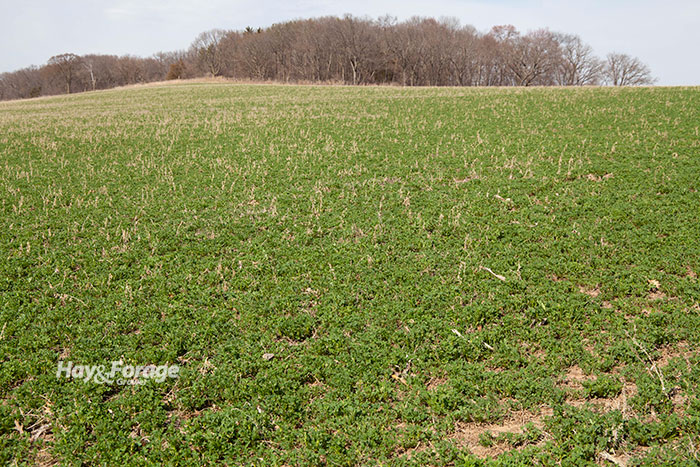
While assessing alfalfa stands this spring, look for plants that are slow to green up or are growing unevenly. These are signs that plants have fallen victim to winter injury, and damage can stunt spring growth and hurt productivity.
Winter injury can occur for many reasons, including several plant- and soil-related issues. Older stands are more susceptible to winterkill, as well as those that are not seeded with winter hardy or disease resistant varieties. Poorly drained soils, those with low fertility, and soils with a pH below 6.6 can enhance winter injury, too.
Dwane Miller, an agronomy extension educator with Penn State University, notes high soil moisture in the fall can worsen winter injury. Improper harvest management last year might be another reason that alfalfa stands look unhealthy this spring.
“The shorter interval between cuttings, the greater the risk of winter injury,” Miller says. “Stands in which the last cutting is taken between September 1 and October 15 are at greater risk, as plants are unable to replenish root carbohydrate reserves before winter.”
Identify the indications
Miller suggests the best way to determine damage is by digging 4 to 6 inches deep in the soil and looking at plant roots. If taproots appear light in color and turgid, they are alive and free from injury. On the other hand, if plants have brown, dehydrated taproots, they have likely experienced winterkill.
Evaluating above-ground biomass is another way to identify winter injury. Spring growth is driven by alfalfa buds that were formed in the fall. However, if these buds were killed by the cold, spring growth will be delayed.
A third strategy for assessing alfalfa is to count the number of stems in a field. Miller says a vigorous stand should have approximately 55 stems per square foot. If stems are not visible early in the season, count plants instead.
“A high-yielding alfalfa stand seeded last year should have 20 plants per square foot,” Miller asserts. “Counts as low as 12 will produce good yields but result in shortened stand life. Stands seeded last spring or fall with fewer than 12 plants per square foot should be disked and reseeded.”
Older alfalfa stands naturally have fewer plants per area, and Miller notes this number should be around six plants per square foot. If a stand produces less than this, he recommends overseeding oats or Italian ryegrass to support forage growth in the months ahead.
Rest and recovery
To help plants recover from winter injury, allow affected plants to mature longer before cutting. Consider the amount of damage to decide the stage at which alfalfa is harvested.
“For severely injured stands, allow plants to go to nearly full bloom in first cut and to early flower in subsequent cuttings. This will give these stands the best chance at survival,” Miller states. “Stands with less injury could be harvested somewhat earlier, depending on the extent of the injury.”
A higher cut height will also benefit plant growth – especially new tillers. Removing these shoots could weaken alfalfa even further, so they must be avoided during harvest. Applying fertilizer to enhance soil fertility and/or applying herbicides to combat weeds can help support a stand that has been injured as well.
Looking ahead, Miller advises producers not to cut damaged forage after September 1. Plants that show signs of winter injury this spring will need more time to build up energy reserves in the fall to endure another round of cold weather.

Amber Friedrichsen served as the 2021 Hay & Forage Grower editorial intern. She currently attends Iowa State University where she is majoring in agriculture and life sciences education-communications and agronomy. Friedrichsen grew up on her family’s diversified crop and livestock farm near Clinton, Iowa.

